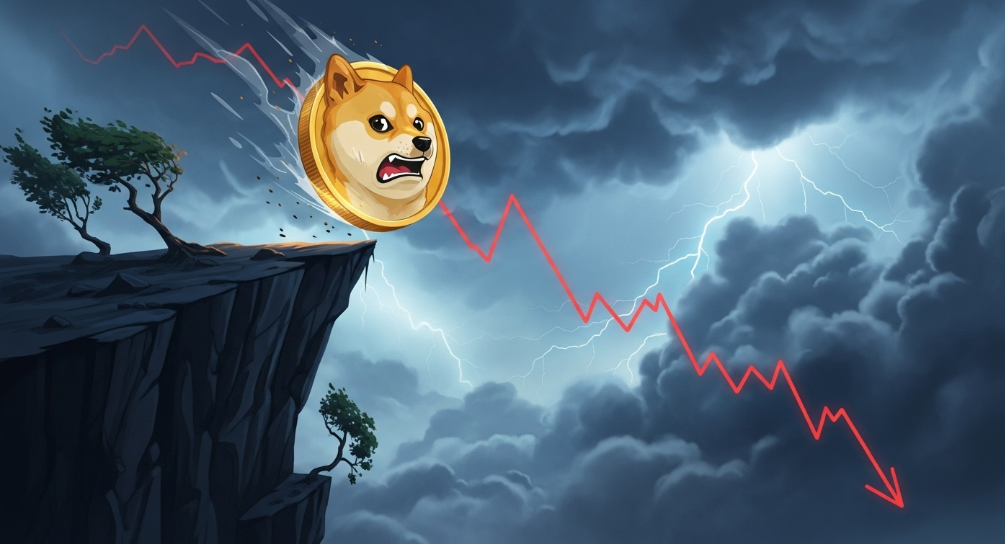In a cryptocurrency crash triggered by Trump's tariff threats, Dogecoin plummeted over 20% in a single week, far exceeding the declines of Bitcoin and Ethereum. This digital asset, which started with a dog meme, is currently facing a severe identity crisis.
On October 10, Trump threatened to "significantly increase" tariffs on China via social media, causing global risk assets to drop sharply and leading to a complete collapse of the cryptocurrency market.
In this storm sweeping across the entire crypto space, meme coins led by Dogecoin have become the most severely damaged asset class. According to AICoin data, DOGE's trading price fell by 23% within a week, significantly higher than Bitcoin's drop of over 10% and Ethereum's decline of about 20%.
Nearly 1.52 million market participants faced liquidation within 24 hours, with a total liquidation amount exceeding $10 billion. This crash exposed structural weaknesses within the cryptocurrency market, particularly the vulnerability of meme coins under macroeconomic pressure.

01 - Market Conditions
● The cryptocurrency market experienced a dramatic crash on October 10, with Bitcoin briefly dropping over 13%, falling below the $110,000 mark, reaching a low of $102,000.

● Major cryptocurrencies like Ethereum, Ripple, and Dogecoin also saw double-digit declines, with the overall market capitalization evaporating by over $250 billion.
● This crash triggered one of the largest liquidation waves in crypto history. According to AICoin data, nearly 1.52 million people faced liquidation globally within 24 hours, with a total liquidation amount exceeding $10 billion.
Panic quickly spread to traditional financial markets, with all three major U.S. stock indices plunging, the Nasdaq dropping over 3%, and European stock markets and international oil prices also falling sharply, as safe-haven funds flocked to traditional assets like gold and government bonds.
02 - Dogecoin's Performance
In this round of market decline, Dogecoin became the worst-performing asset among the top 20 cryptocurrencies, with a weekly drop exceeding 23%, trading below $0.19.
In contrast, Bitcoin and Ethereum fell by about 10% over the past week. This significant difference reveals the varying performances of different categories of cryptocurrencies when facing macroeconomic pressures.
After the crash on Friday, Dogecoin slightly rebounded from a low of $0.18 but struggled to achieve any substantial gains.

03 - Causes of the Crash
● Macro Black Swan: Trump's Tariff Surprise
The direct trigger for this crash was Trump's tariff threat. On October 10, Trump posted a threat on Truth Social to impose a 100% tariff on China, instantly igniting global market risk aversion.
Following the tariff announcement, the cryptocurrency market plummeted, with Bitcoin experiencing a daily drop of about 10% and Ethereum falling approximately 13%.
● Internal Market Factors: High Leverage and Liquidity Drain
The crypto market entered this crisis with high open interest and strong risk appetite. Bitcoin futures open interest once surged to a historical high of $30 billion.
When prices fell below key support levels, a large amount of programmatic trading was triggered, creating a chain reaction that led to a vicious cycle. Multiple perpetual contract platforms triggered automatic liquidations, forming a pro-cyclical death spiral when the order book thinned.
● On-chain Pressure and Large-scale Sell-offs
The market showed signs of approximately 12,000 Bitcoins (worth about $1.4 billion) being transferred to exchanges for sale.
At the same time, rumors circulated that the U.S. Justice Department might liquidate $8 billion worth of involved Bitcoins, putting immense pressure on the market.
04 - Why Dogecoin's Decline Exceeds Mainstream Coins
● Meme Coins' Emotion-driven Nature
“DOGE's rebound is not as strong as other coins because meme tokens are more susceptible to emotional fluctuations,” said Maja Vujinovic, co-founder and CEO of digital asset firm FG Nexus.
“When fear spreads, they are often the first to lose momentum. With weakened on-chain demand and more speculative holders emerging, I believe DOGE shows lower resilience: it suffers more when the broader market contracts.”
● Lack of Intrinsic Value Support
Dogecoin was created as a joke to mock the cryptocurrency space. Although it gained a large following due to Musk's endorsement, the asset still lacks real use cases.
Market observers pointed out in September that the coin lacks genuine use cases—something that investors are increasingly concerned about in the crypto industry.
● Identity Crisis and Competitive Pressure
Jonathan Morgan, chief crypto analyst at Stocktwits, noted: “[DOGE] is no longer the speculative asset it once was in the cryptocurrency space. My goodness, it has its own digital asset treasury in the stock market. It is in an identity crisis; sure, it is a meme coin—but is it part of the current meme coin culture?”
Despite Dogecoin's large market capitalization, those looking to engage in meme coin trading see better returns elsewhere.
Dogecoin's volatility remains greater than that of other large-cap coins, but new popular meme coins continue to emerge and soar quickly (and often crash just as fast).
● Institutional Behavior Differences
During the crash, institutional funds clearly favored mainstream assets. Data shows that after accumulating 1.5 billion Dogecoin tokens near the $0.20 support level, there were signs of new whale fund inflows.
However, this accumulation was not enough to offset the widespread selling pressure. Meanwhile, while Bitcoin and Ethereum ETFs also experienced fund outflows, they still maintained considerable institutional interest.
05 - Comparison of Risk Resilience Among Different Cryptocurrencies
The table below clearly shows the differences in risk resilience among the three major cryptocurrencies across multiple dimensions:
Comparison Dimension
Bitcoin (BTC)
Ethereum (ETH)
Dogecoin (DOGE)
Price Change (Past Week)
Down about 10%
Down about 10%
Down 23%
Value Support
Digital gold status, fixed supply cap
Smart contract platform, large ecosystem
Community sentiment, celebrity endorsements
Institutional Participation
High (ETFs, corporate treasuries)
High (ETFs, Web3 applications)
Relatively low
Leverage Risk Exposure
Medium
Medium
High
Emotional Dependency
Relatively low
Relatively low
Extremely high
Practical Use Cases
Value storage
DeFi, NFTs, national digital identity systems
Very few
Source: AICoin compilation
From the table, it is evident that Dogecoin is significantly weaker than Bitcoin and Ethereum in key dimensions such as value support, institutional participation, and practical use cases, which explains why DOGE's performance lags far behind mainstream cryptocurrencies when the market faces pressure.

Conclusion
Dogecoin's creator, Billy Markus, once admitted that creating the coin was just "for fun, to mock the craziness of cryptocurrency." In hindsight, this meme coin remains the first to be toppled in the face of macro storms.
The institutional funds' support near $0.20 can only provide a brief respite, and as market consensus shifts from "take a chance" to "wait and see," DOGE, lacking actual application support, naturally becomes a priority for selling.
Bitcoin has the narrative of "digital gold," Ethereum has a solid ecosystem of applications, while Dogecoin is left with just that smirking dog meme.
免责声明:本文章仅代表作者个人观点,不代表本平台的立场和观点。本文章仅供信息分享,不构成对任何人的任何投资建议。用户与作者之间的任何争议,与本平台无关。如网页中刊载的文章或图片涉及侵权,请提供相关的权利证明和身份证明发送邮件到support@aicoin.com,本平台相关工作人员将会进行核查。


